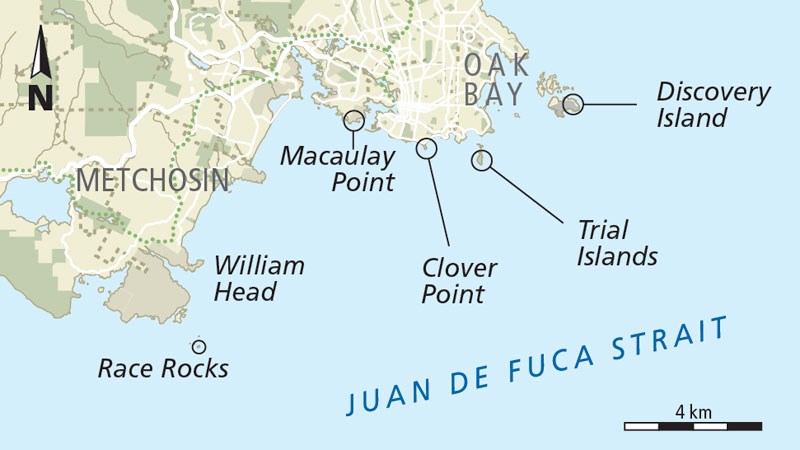The federal government’s shellfish closure zone off Victoria should be expanded because of pollution from untreated sewage, says a group of environmental organizations.
New sampling shows sewage pollution exceeds federal limits as far away as William Head, near Metchosin, and Trial Islands, near Oak Bay, according to figures released Thursday by the T. Buck Suzuki Environmental Foundation, the Georgia Strait Alliance and the David Suzuki Foundation.
Those sites are farther than Environment Canada’s current 60-square-kilometre shellfish closure zone off Greater Victoria, the groups said. They suggested expanding the closure zone to span from Race Rocks to Discovery Island.
The Capital Regional District discharges almost 130 million litres of sewage a day into the ocean through underwater outfalls off Macaulay and Clover points. The waste is screened for solids but is otherwise not treated.
“We weren’t expecting to see them this high,” said Jim McIsaac, of the T. Buck Suzuki Foundation, of the pollution levels. “The currents, obviously, are taking it.”
Divers took samples at seven locations, at depths up to 20 metres, and processed them a laboratory at the University of Victoria. The groups said they found fecal coliform levels at more than 2,400 per 100 millilitres at William Head and Trial Island West.
Environment Canada has a safe swimming water standard of 200 fecal coliforms per 100 ml, and 14 per 100 ml for shellfish pollution.
“The shellfish at the bottom of the sea are being exposed to sewage,” said John Werring of the David Suzuki Foundation.
The level off Saxe Point was 210 fecal coliforms per 100 ml, according to the groups.
“It’s shocking,” said CRD sewage director Judy Brownoff. “People who say dilution is the solution, I think this is showing it’s travelling.”
Past CRD testing has shown fecal coliform levels generally below federal limits on the surface near the two sewage outfalls, but exceeding guidelines at the bottom of the ocean floor.
The environmental groups are encouraging the CRD to push forward on its $783-million plan for secondary sewage treatment by 2018.
Critics say that plan is flawed, and the environment would be better served by a higher level of treatment using smaller plants distributed throughout the region. Other critics, including retired health officials and marine scientists, insist the sewage is dispersed safely in the cold deep currents of the Pacific Ocean.
Even after sewage treatment begins, the CRD will continue to discharge pollution into the ocean caused by urban runoff in storm water discharges, said Richard Atwell, who organizes StopaBadPlan.ca.
“Unfortunately, the federal regulations that the CRD sewage project is designed to meet won’t eliminate fecal coliforms, just reduce them to regulated levels,” he said.
Other sewage treatment critics have argued that the treatment process will do little to tackle pharmaceuticals and heavy metals found in the waste.



